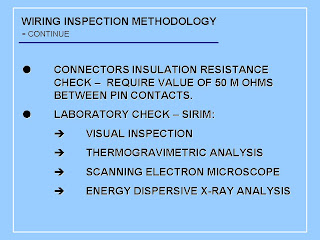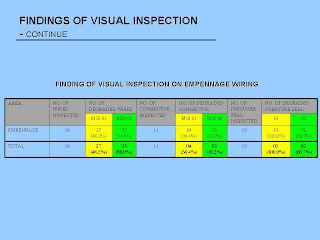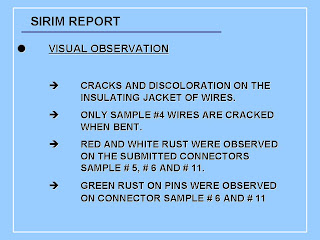Aircraft Traffic alert and Collision Avoidance System (TCAS)
>> Friday, August 28, 2009
TCAS
The Traffic alert and Collision Avoidance System (or TCAS) is an aircraft collision avoidance system designed to reduce the incidence of mid-air collisions between aircraft. It monitors the airspace around an aircraft for other aircraft equipped with a corresponding active transponder, independent of air traffic control, and warns pilots of the presence of other transponder-equipped aircraft which may present a threat of mid-air collision (MAC). It is an implementation of the Airborne Collision Avoidance System mandated by International Civil Aviation Organization to be fitted to all aircraft with MTOM (maximum take-off mass) over 5700 kg (12,586 lbs) or authorised to carry more than 19 passengers.
Official definition from PANS-ATM (Nov 2007): ACAS / TCAS is an aircraft system based on secondary surveillance radar (SSR) transponder signals which operates independently of ground-based equipment to provide advice to the pilot on potential conflicting aircraft that are equipped with SSR transponders.
In modern glass cockpit aircraft, the TCAS display may be integrated in the Navigation Display (ND); in older glass cockpit aircraft and those with mechanical instrumentation, such an integrated TCAS display may replace the mechanical Instantaneous Vertical Speed Indicator (which indicates the rate with which the aircraft is descending or climbing).
TCAS basics
TCAS involves communication between all aircraft equipped with an appropriate transponder (provided the transponder is enabled and set up properly). Each TCAS-equipped aircraft "interrogates" all other aircraft in a determined range about their position (via the 1030 MHz radio frequency), and all other craft reply to other interrogations (via 1090 MHz). This interrogation-and-response cycle may occur several times per second.
Through this constant back-and-forth communication, the TCAS system builds a three dimensional map of aircraft in the airspace, incorporating their bearing, altitude and range. Then, by extrapolating current range and altitude difference to anticipated future values, it determines if a potential collision threat exists.
TCAS and its variants are only able to interact with aircraft that have a correctly operating Mode C or Mode S transponder. A unique 24-bit identifier is assigned to each aircraft that has a Mode S transponder. These identifiers can be decoded online using tools such as those at Airframes.org.
The next step beyond identifying potential collisions is automatically negotiating a mutual avoidance maneuver (currently, maneuvers are restricted to changes in altitude and modification of climb/sink rates) between the two (or more) conflicting aircraft. These avoidance maneuvers are communicated to the flight crew by a cockpit display and by synthesized voice instructions.
Safety aspects of TCAS
Safety studies on TCAS estimate that the system improves safety in the airspace by a factor of between 3 and 5.
However, it is well understood that part of the remaining risk is that TCAS may induce midair collisions: "In particular, it is dependent on the accuracy of the threat aircraft’s reported altitude and on the expectation that the threat aircraft will not make an abrupt maneuver that defeats the TCAS RA. The safety study also shows that TCAS II will induce some critical near midair collisions..." (See page 7 of Introduction to TCAS II Version 7 (PDF) in external links below).
One potential problem with TCAS II is the possibility that a recommended avoidance maneuver might direct the flight crew to descend toward terrain below a safe altitude. Recent requirements for incorporation of ground proximity mitigate this risk. Ground proximity warning alerts have priority in the cockpit over TCAS alerts.
Some pilots have been unsure how to act when their aircraft was requested to climb whilst flying at their maximum altitude. The accepted procedure is to follow the climb RA as best as possible, temporarily trading speed for height. The climb RA should quickly finish. In the event of a stall warning, the stall warning would take priority.
Versions of TCAS
PASSIVE
Collision Avoidance systems which rely on transponder replies triggered by ground and airborne systems are considered passive. Ground and airborne interrogators query nearby transponders for mode C altitude information, which can be monitored by third-party systems for traffic information. Passive systems display traffic similar to TCAS, however generally have a range of less than 7 nautical miles (13 km). Portable Collision Avoidance System.
TCAS I
TCAS I is the first generation of collision avoidance technology. It is cheaper but less capable than the modern TCAS II system, and is mainly intended for general aviation use. TCAS I systems are able to monitor the traffic situation around a plane (to a range of about 40 miles) and offer information on the approximate bearing and altitude of other aircraft. It can also generate collision warnings in the form of a "Traffic Advisory" (TA). The TA warns the pilot that another aircraft is in near vicinity, announcing "traffic, traffic", but does not offer any suggested remedy; it is up to the pilot to decide what to do, usually with the assistance of Air Traffic Control. When a threat has passed, the system announces "clear of conflict".
TCAS II
TCAS II is the second and current generation of instrument warning TCAS, used in the majority of commercial aviation aircraft (see table below). It offers all the benefits of TCAS I, but will also offer the pilot direct, vocalized instructions to avoid danger, known as a "Resolution Advisory" (RA). The suggestive action may be "corrective", suggesting the pilot change vertical speed by announcing, "descend, descend", "climb, climb" or "Adjust Vertical Speed Adjust" (meaning reduce vertical speed). By contrast a "preventive" RA may be issued which simply warns the pilots not to deviate from their present vertical speed, announcing, "monitor vertical speed" or "maintain vertical speed". TCAS II systems coordinate their resolution advisories before issuing commands to the pilots, so that if one aircraft is instructed to descend, the other will typically be told to climb — maximising the separation between the two aircraft.
As of 2006, the only implementation that meets the ACAS II standards set by ICAO is Version 7.0 of TCAS II, produced by three avionics manufacturers: Rockwell Collins, Honeywell, and ACSS (Aviation Communication & Surveillance Systems; an L-3 Communications and Thales Avionics company).
TCAS III
TCAS III was the "next generation" of collision avoidance technology which underwent development by aviation companies such as Honeywell. TCAS III incorporated technical upgrades to the TCAS II system, and had the capability to offer traffic advisories and resolve traffic conflicts using horizontal as well as vertical manouevring directives to pilots. For instance, in a head-on situation, one aircraft might be directed, "turn left, climb" while the other would be directed "turn right, descend." This would act to further increase the total separation between aircraft, in both horizontal and vertical aspects. Horizontal directives would be useful in a conflict between two aircraft close to the ground where there may be little if any vertical maneuvering space. All work on TCAS III is currently suspended and there are no plans for its implementation.
Current implementation
Although the system occasionally suffers from false alarms, pilots are now under strict instructions to regard all TCAS messages as genuine alerts demanding an immediate, high-priority response. (Only stall warnings and Ground Proximity Warning System warnings have higher priority than the TCAS.) The FAA and most other countries' authorities' rules state that in the case of a conflict between TCAS RA and air traffic control (ATC) instructions, the TCAS RA always takes precedence (this is mainly because of the TCAS-RA inherently possessing a more current and comprehensive picture of the situation than air traffic controllers, whose radar/transponder updates usually happen at a much slower rate than the TCAS interrogations). If one aircraft follows a TCAS RA and the other follows conflicting ATC instructions, a collision can occur, such as the July 1, 2002 Überlingen disaster. In this mid-air collision, both airplanes were fitted with TCAS II systems which functioned properly, but one obeyed the TCAS advisory while the other ignored the TCAS and obeyed the controller; both aircraft descended into a fatal collision.
Current TCAS Limitations
While the benefits of TCAS are undisputable, it can be assumed that TCAS' true technical and operational potential (and thus its possible benefits) is not yet being fully exploited because of the following limitations in current implementations (most of which will need to be addressed in order to further facilitate the design and implementation of Free flight):
• TCAS is limited to supporting only vertical separation advisories, more complex traffic conflict scenarios may however be more easily and efficiently remedied by also making use of lateral resolution maneuvers; this applies in particular to traffic conflicts with marginal terrain clearance, or conflict scenarios that are similarly restricted by vertical constraints (e.g. in busy RVSM airspace)
• ATC can be automatically informed about resolution advisories issued by TCAS only when the aircraft is within an area covered by a Mode S, or an ADS-B monitoring network. In other cases controllers may be unaware of TCAS-based resolution advisories or even issue conflicting instructions (unless ATC is explicitly informed by cockpit crew members about an issued RA during a high-workload situation), which may be a source of confusion for the affected crews while additionally also increasing pilot work load. In May 2009, Luxembourg, Hungary and the Czech Republic show downlinked RAs to controllers.
• In the above context, TCAS lacks automated facilities to enable pilots to easily report and acknowledge reception of a (mandatory) RA to ATC (and intention to comply with it), so that voice radio is currently the only option to do so, which however additionally increases pilot and ATC workload, as well as frequency congestion during critical situations.
• In the same context, situational awareness of ATC depends on exact information about aircraft maneuvering, especially during conflict scenarios that may possibly cause or contribute to new conflicts by deviating from planned routing, so automatically visualizing issued resolution advisories and recalculating the traffic situation within the affected sector would obviously help ATC in updating and maintaining situational awareness even during unplanned, ad hoc routing changes induced by separation conflicts.
• Today's TCAS displays do not provide information about resolution advisories issued to other (conflicting) aircraft, while resolution advisories issued to other aircraft may seem irrelevant to another aircraft, this information would enable and help crews to assess whether other aircraft (conflicting traffic) actually comply with RAs by comparing the actual rate of (altitude) change with the requested rate of change (which could be done automatically and visualized accordingly by modern avionics), thereby providing crucial realtime information for situational awareness during highly critical situations.
• TCAS equipment today is often primarily range-based, as such it only displays the traffic situation within a configurable range of miles/feet, however under certain circumstances a "time-based" representation (i.e. within the next xx minutes) might be more intuitive.
• Lack of terrain/ground and obstacle awareness (e.g. connection to TAWS, including MSA sector awareness), which might be critical for creating feasible (non-dangerous, in the context of terrain clearance) and useful resolution advisories (i.e. prevent extreme descent instructions if close to terrain), to ensure that TCAS RAs never facilitate CFIT (Controlled Flight into Terrain) scenarios.
• Aircraft performance in general and current performance capabilities in particular (due to active aircraft configuration) are not taken into account during the negotiation and creation of resolution advisories (as it is the case for differences between different types of aircraft, e.g. turboprop/jet vs. helicopters), so that it is theoretically possible that resolution advisories are issued that demand climb or sink rates outside the normal/safe flight envelope of an aircraft during a certain phase of flight (i.e. due to the aircraft's current configuration), furthermore all traffic is being dealt with equally, there's basically no distinction taking place between different types of aircraft, neglecting the option of possibly exploiting aircraft-specific (performance) information to issue customized and optimized instructions for any given traffic conflict (i.e. by issuing climb instructions to those aircraft that can provide the best climb rates, while issuing descend instructions to aircraft providing comparatively better sink rates, thereby hopefully maximizing altitude change per time unit, that is separation)
• TCAS is primarily extrapolation-oriented, as such it is using algorithms trying to approximate 4D trajectory prediction using the "flight path history", in order to assess and evaluate the current traffic situation within an aircraft's proximity, however the degree of data- reliability and usefulness could be significantly improved by enhancing said information with limited access to relevant flight plan information, as well as to relevant ATC instructions to get a more comprehensive picture of other traffic's (route) plans and intentions, so that flight path predictions would no longer be merely based on estimations but rather actual aircraft routing (FMS flight plan) and ATC instructions. If TCAS is modified to use data that is used by other systems, care will be required to ensure that the risks of common failure modes are sufficiently small.
• TCAS is not fitted to many smaller aircraft mainly due to the high costs involved (between $25,000 and $150,000). Many smaller personal business jets for example, are currently not legally required to have TCAS installed, even though they fly in the same airspace as larger aircraft that are required to have proper TCAS equipment on board. TCAS can however only develop its true operational potential once all aircraft in any given airspace can be safely assumed to have a properly working TCAS unit on board.



































